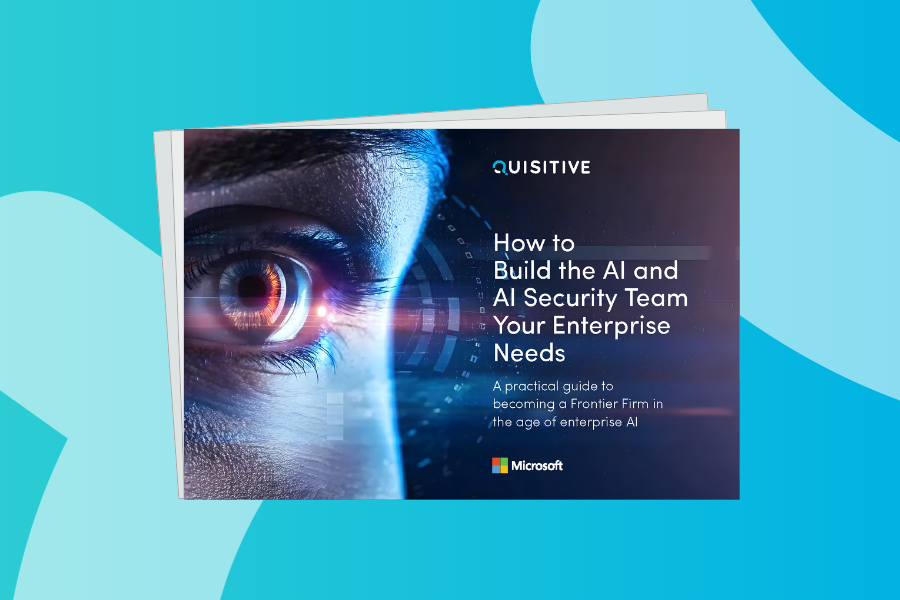Small and medium-sized businesses (SMBs) face mounting pressure to accomplish more with fewer resources. AI and automation technologies offer enticing opportunities to boost efficiency and competitiveness. Studies show that AI-powered automation can increase productivity by up to 40%, giving small businesses a significant competitive advantage.
However, with only 20% of SMBs having AI risk management frameworks (compared to 50% of large corporations), many smaller organizations remain vulnerable to data breaches, privacy violations, and flawed decision-making based on unreliable AI outputs.
This guide provides tech and cybersecurity leaders with a practical roadmap for implementing AI for SMBs safely while maximizing productivity benefits.
In this blog:
- Understanding the AI Security Landscape
- The Importance of an AI Risk Assessment Framework for Secure Implementations
- Safeguarding Data and Ensuring Accurate AI Decisions
- 4 AI Use Cases that Provide Safe Productivity Gains for SMBs
- 3 Best Practices for Long-Term Success
Understanding the AI Security Landscape
Common security considerations for SMBs include:
- Data Privacy Vulnerabilities: AI systems require significant data to operate effectively, potentially exposing sensitive information if not properly protected.
- Algorithm Manipulation: AI models can be susceptible to adversarial attacks or data poisoning, where input data is subtly altered to affect outputs or obtain sensitive information.
- Intellectual Property Exposure: Confidential information might inadvertently be used as input for generative AI, potentially leading to unauthorized data exposure.
- Lack of Algorithmic Transparency: The complexity of AI algorithms can obscure their decision-making processes, making it difficult to identify and address potential security issues.
- Third-Party Provider Risks: Relying on external AI vendors introduces risks if those providers do not have adequate security protocols or compliance measures.
The Importance of an AI Risk Assessment Framework for Secure Implementations
Understanding and evaluating potential risks before adopting any AI solution is essential for making informed implementation decisions. To determine where and how to implement secure AI, consider this structured approach:
- Identify Specific Business Needs: Rather than implementing AI for its own sake, pinpoint the exact problems or inefficiencies that AI could address.
- Assess Data Sensitivity: Evaluate the types of data the AI system would process and its potential business impact if compromised.
- Evaluate Implementation Options: Consider build-vs-buy decisions, vendor security credentials, and deployment models (on-premises vs. cloud).
- Determine Appropriate Controls: Establish security measures proportional to the identified risk level.
- Start Small and Scale: Begin with low-risk, high-impact implementations before expanding to more sensitive applications.
USE CASE
A law firm successfully implemented this approach by deploying a centralized AI platform with role-based access controls, reducing administrative hours by 35% without compromising data integrity.
Safeguarding Data and Ensuring Accurate AI Decisions
The productivity benefits of AI for SMBs are only valuable if they don’t compromise data security or lead to flawed decisions. Here’s how to protect both:
Data Governance Best Practices
Implement a structured approach to data management:
- Data Classification: Categorize data based on sensitivity and implement appropriate controls for each level.
- Access Controls: Limit AI system access to only the data necessary for its function.
- Data Minimization: Provide only the information the AI needs to perform its task.
- Regular Audits: Periodically review the data your AI systems access and process.
Ensuring Data Quality for Accurate Decisions
AI is only as good as the data it’s trained on. To ensure accurate outputs:
- Data Cleaning: Before using data for AI training or operations, remove duplicates, fix errors, and standardize formats15.
- Representative Samples: Ensure training data covers the full range of scenarios the AI will encounter.
- Continuous Validation: Regularly compare AI outputs against known-good results to catch drift or deterioration in accuracy.
- Feedback Loops: Create mechanisms to capture and incorporate corrections when the AI makes mistakes.
Maintaining Human Oversight
Even the best AI systems require appropriate human supervision:
- Implement Review Workflows: Establish processes for human review of AI outputs, especially for high-impact decisions.
- Set Confidence Thresholds: Configure AI systems to escalate to human review when confidence levels fall below certain thresholds.
- Conduct Regular Audits: Periodically review a sample of AI decisions to ensure quality and identify potential improvements.
- Document Decision Criteria: Maintain clear documentation of how AI systems make decisions to facilitate oversight and troubleshooting.
USE CASE
A logistics company successfully implemented an AI chatbot for customer inquiries but mandated human review for sensitive responses, creating a hybrid approach safeguarding against inaccuracies while streamlining customer support.
4 AI Use Cases that Provide Safe Productivity Gains for SMBs
Based on extensive research and real-world examples, here are four specific AI for SMBs that offer significant productivity benefits while maintaining data security and decision quality when properly deployed:
1. AI-Powered Customer Service Chatbots
AI chatbots can handle routine customer inquiries, answer FAQs, and provide support 24/7.
Productivity benefits:
40% of retailers use AI for customer service, saving time and improving response rates. Chatbots manage multiple inquiries at once, allowing staff to focus on complex issues.
Security considerations:
- Limit chatbot access to sensitive data
- Clear escalation paths for complex inquiries
- Regularly review conversation logs for security issues
- Compliance with data protection regulations
Ensuring decision quality:
- Train chatbots with accurate information from verified sources
- Use confidence thresholds to trigger human review when uncertain
- Audit responses regularly and create feedback loops
- Specialized tools like Tidio offer 24/7 AI chat, boosting conversions and satisfaction. Microsoft Copilot also has a variety of different AI solutions that could be used as well
Implementation tip:
Start small, then expand as performance is validated.
2. Content Generation and Marketing Automation
AI tools such as Microsoft Copilot and Jasper AI can assist in creating marketing copy, social media posts, and email campaigns, while platforms like HubSpot AI can automate campaign execution.
Productivity benefits:
Small and medium-sized businesses (SMBs) save an average of 40 minutes per week on marketing tasks, with AI aiding in content generation, trend identification, and campaign optimization.
Security considerations:
- Review all AI-generated content before publication.
- Avoid inputting sensitive or proprietary information into general-purpose AI tools.
- Use tools with strong data protection policies.
- Maintain human oversight of campaign strategies.
Ensuring decision quality:
To prevent inaccurate or inappropriate content:
- Provide clear guidelines and examples when prompting AI content generators.
- Establish a multi-step review process for all AI-generated materials.
- Train the system with your brand voice and approved messaging.
- Start with tools like Grammarly for AI-powered writing assistance. These tools help you craft explicit and professional emails and content without hiring an editor.
Implementation tip:
Begin with low-risk content such as product descriptions or blog post drafts, establishing a human review process before expanding to more complex marketing materials.
3. Inventory Management and Demand Forecasting
AI systems can analyze sales patterns, predict demand fluctuations, and optimize inventory levels, reducing both stockouts and overstocking.
Productivity benefits:
AI-powered inventory management helps reduce stockouts by 40%, optimizes supply chains, and improves cash flow by preventing excessive inventory.
Security considerations:
- Use anonymized or aggregated data when possible
- Implement strong access controls for inventory systems
- Regularly validate AI predictions against actual results
- Maintain manual override capabilities for unusual circumstances
Ensuring decision quality:
To prevent costly inventory mistakes:
- Ensure historical sales data is clean and complete and accounts for seasonal variations
- Incorporate external factors that impact demand (like promotions market trends)
- Set alerts for predictions that fall outside expected ranges
- Gradually increase reliance on AI forecasts as accuracy is demonstrated over time
Implementation tip:
To test the system, start with a single product category before expanding.
4. AI-Enhanced Cybersecurity Monitoring
AI security tools can analyze patterns, detect anomalies, and identify potential threats efficiently.
Productivity benefits:
AI-powered security monitoring can decrease investigation time by up to 60% while enhancing threat detection accuracy.
Security considerations:
- Use in addition to existing security measures
- Ensure proper configuration to reduce false positives
- Maintain human oversight of security alerts and responses
- Update and retrain models regularly to detect new threat patterns
Ensuring decision quality:
To avoid false alarms or missed threats:
- Establish baseline normal behavior before enabling alert features
- Tune detection thresholds according to your specific environment
- Implement a scoring system for prioritizing alerts
- Regularly review both triggered alerts and sampled non-alerts to validate system performance
- Consider AI fraud detection tools that can help mitigate financial losses by 50%
Implementation tip:
Implementation tip: Use AI to monitor a single system or threat vector, validating the results before expanding coverage.
AI for SMBs: 3 Best Practices for Long-Term Success
1. Start Small and Scale Gradually
Begin with clearly defined, limited-scope projects that deliver measurable value. Then, validate your results in controlled environments before deploying them widely. Finally, use what you learned from initial implementations to inform expansion plans.
2. Vendor Selection and Management
When choosing AI providers:
- Prioritize security credentials and compliance certifications
- Evaluate data handling practices and privacy policies
- Assess transparency regarding algorithm operation
- Consider the vendor’s financial stability and long-term viability
- Engage an AI consulting company like Quisitive to help you develop your AI journey with expert guidance
3. Employee Training and Change Management
AI will alter the way that your employees work. Ensure they are prepared by:
- Offer training on the use of AI tools and understanding their limitations
- Discuss job displacement concerns by highlighting how AI complements human work
- Establish clear guidelines for when to use AI versus human judgment
- Showcase initial successes to gain organizational support
4. Continuous Monitoring and Evaluation
Establish metrics to track both security and productivity:
- Operational Metrics: Process times, error rates, automation levels
- Security Metrics: Incidents, vulnerabilities, compliance issues
- Financial Impact: Cost savings, productivity improvements, ROI
Regular assessment against these metrics helps ensure AI implementations remain both secure and beneficial.
Need help maintaining and optimizing your AI solutions? Consider Managed AI Services to ensure your technology continues to operate at peak performance.
Looking at the future of AI for SMBs
AI holds immense potential for SMB tech and cyber leaders who are under pressure to achieve more with fewer resources. Small businesses can reap significant productivity gains by adopting a risk-based strategy, focusing on key implementations, safeguarding data, and ensuring decision quality.
AI isn’t exclusive to large enterprises. With a measured, security-first strategy, SMBs can utilize these technologies to compete while protecting their data, decisions, and customers’ trust.
If you need help starting your secure AI journey, I recommend taking our AI Security Assessment. Quisitive’s certified experts will help you evaluate your current environment, develop key AI governance policies, and outline the next steps toward secure AI adoption.

;)



